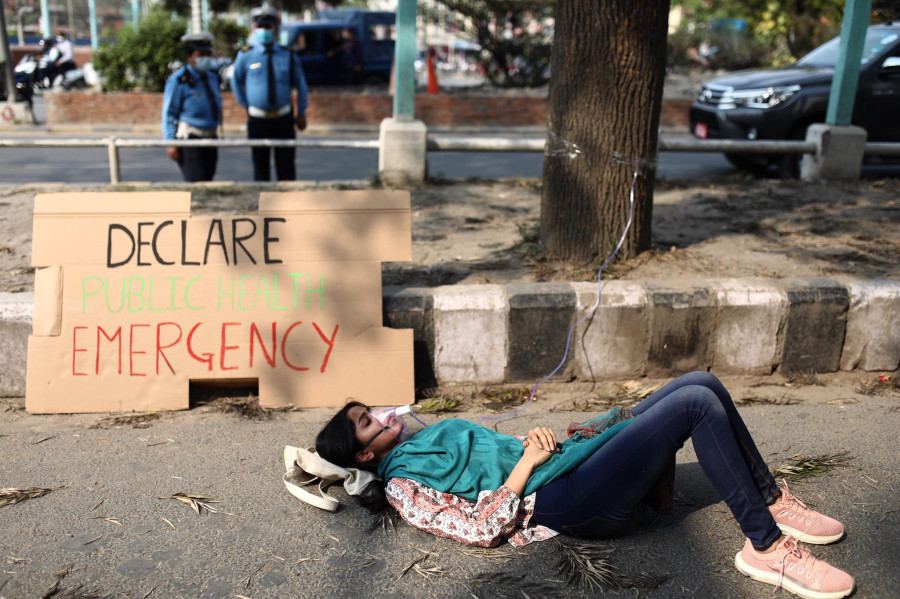Climate & Environment
Experts urge long-term strategy for curbing air pollution in the country
Although forest fire has been the main factor of late, experts point out other causes like emissions from vehicles and construction and factory sectors, and open burning.
Chandan Kumar Mandal
At a time when the country is engulfed in an atmosphere polluted to hazardous levels, scientists, experts and common people worry that nothing much is being done to curb air pollution.
For the last two weeks, different parts of the country including Kathmandu Valley have remained shrouded in thick haze and harmful levels of air pollution, posing a serious risk to public health.
During a virtual interaction organised by the Nepal Academy of Science and Technology (NAST) on Thursday, experts stressed the need for a long-term strategy to combat air pollution that causes headache for the nation every year.
“The country is facing a severe level of air pollution. However, we are only talking about a few pollutant particles, mainly the Air Quality Index (AQI) value,” said Sunil Babu Shrestha, vice-chancellor of the Academy.
“More studies are required to understand other pollutants. A preliminary study of NAST shows there are also harmful bacterias in the air that can severely affect the population.”
The ongoing spell of air pollution is linked with wildfires raging across the country. The devastating forest fires, which have been reported from 73 districts, added to the hazardous smoke in the atmosphere, polluting the air in different parts of the country.
Kathmandu continues to rank among the most polluted cities in the world. With an AQI reading of 152, the Capital was once again ranked the third most polluted city in the world at 2:45 pm Thursday.
On Tuesday and Wednesday, Kathmandu was marked as the most polluted city in the world with the highest daily AQI reading of 342 and 308, respectively.
“Forest fire is taken as the main reason behind the deterioration in air quality lately,” said Shrestha. “However, we also need to find out contributions of other sources of pollution like vehicular emissions, open waste burning, and dust coming from construction sites and industries, among others.”
Nepal is going through its worst forest fire season. Since March 1, the country has witnessed over 1,800 incidents of bush fire across the country. Last week, brief rainfall had given a temporary respite from the dangerous air pollution and wildfires before the fires intensified this week, once again causing a dip in air quality across the country.
Following the rains, AQI came down to 42 on March 31.
“The constitution guarantees us the right to live in a healthy environment. Should the state not be held responsible for not ensuring our rights?” said Dinesh Raj Bhuju, an academician with NAST. “We are living with dangerous levels of air pollution. It is hard to accept that Kathmandu is among the most polluted cities in the world. For more than two and a half weeks, the country has remained blanketed in dense haze and smoke.”
Bhuju pointed out that there are generally three main factors of air pollution—vehicular emissions, dusty roads and pollution from factories. At the moment though, forest fires are the leading cause of poor quality air.
After massive forest fires worsened air pollution this year, the issue ignored for a long time has gained some attention, said Bhuju, a forest ecologist. “Different studies estimate that the country loses from 100,000 to 400,000 hectares of forest every year. The massive annual forest losses to wildfires shows even scientific communities did not pay adequate attention to wildfires, which is evident that there is a small number of studies on forest fires, especially their link with air pollution.”
On Thursday afternoon, 43 forest fires were reported while the Forest Fire Detection and Monitoring System, a Nepal government website, recorded 177 wildfires in the last 24 hours.
“This year, the reason behind air pollution might be different but its impacts are still the same,” said Dr Ashesh Dhungana, associate professor and chief consultant chest physician at the National Academy of Medical Sciences, Bir Hospital. “Nepal is ranked at top for the wrong reason of air pollution. The current situation, when AQI levels are crossing the 300 mark, calls for a public health emergency. Even at 11pm, when there are low vehicular emissions and industries are closed, AQI levels have been recorded over 300.”
Pollution is not limited to Kathmandu Valley, which sees a spike during the dry season. Major cities including Pokhara, Bharatpur and Simara have also been engulfed in poor quality air.
“As air pollution gets severe and the general public’s exposure to such poor quality air increases, they can experience more serious, irreversible, debilitating and life-threatening health complications. Such a level of air pollution affects people throughout their lifetime,” said Dr Dhungana.
“While we are so scared of Covid-19, which has killed some 3,000 people, air pollution kills around 40,000 people in Nepal every year. Such a level of pollution should also be of as much worry. Not going out and wearing a good quality mask can only be a short-term solution, but we need to find long term solutions to air pollution as the problem occurs every year.”
According to Nabin Pokharel, a senior divisional engineer at the Ministry of Forest and Environment, the government is working on plans to fight air pollution in sustainable ways.
“The government is working on enforcing Euro Six emission standards for vehicles. The existing emissions guidelines for in-operation vehicles are being revised as well,” said Pokharel.
“Also, there are plans to set the standards for heavy equipment like road rollers, cranes and excavators. All these works will be completed and enforced within this year.”




 14.12°C Kathmandu
14.12°C Kathmandu








%20(1).jpg&w=300&height=200)

